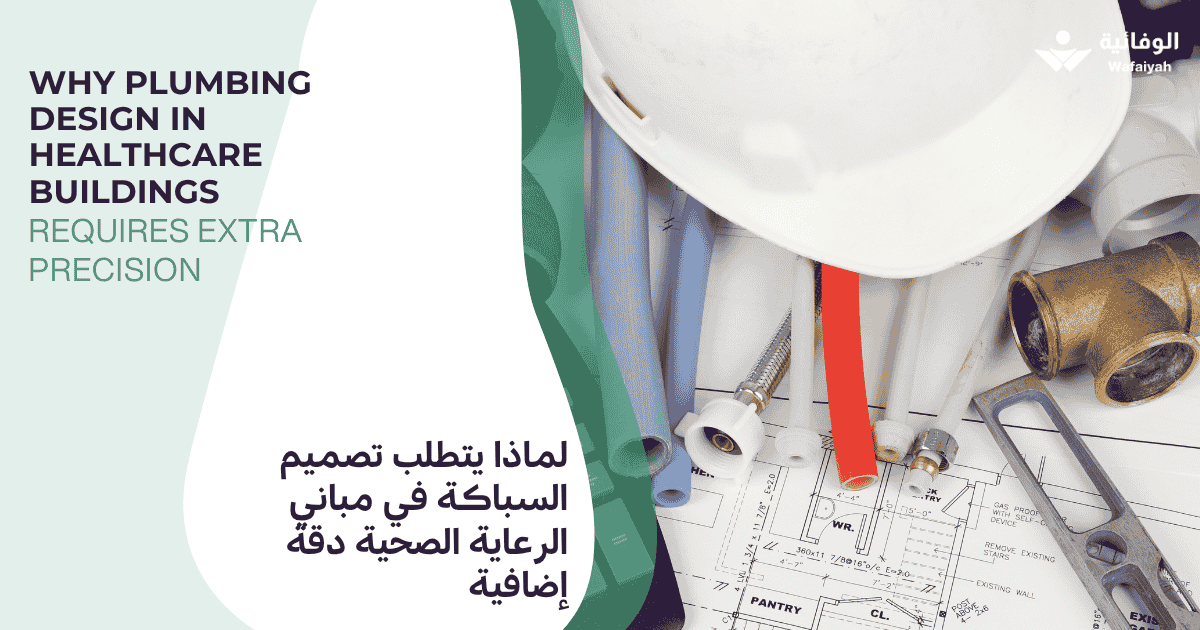The unseen hero of healthcare building is the plumbing system, quietly ensuring hospitals, clinics, and medical facilities run smoothly. Unlike commercial or residential buildings, healthcare plumbing requires extra precision, as it directly impacts patient safety, hygiene, and overall operational performance. Every pipe, valve, and fixture must meet strict regulatory standards while supporting the unique demands of medical environments. Wafaiyah knows that careful plumbing design is more than just functionality; it’s a significant component that protects patients, supports staff, and keeps healthcare facilities operating flawlessly.
Plumbing in healthcare facilities has a significant role to play in the safety, hygiene, and comfort of patients and the staff. A proper sanitation system ensures that water is clean to drink, and you can safely use it for medical care. A well-maintained ping system also serves to contain infections, as well as to maintain sanitation, and allow the proper functioning of vital devices.
Patient rooms to surgery scrubbing, all spaces require an adequate water supply and drainage. Sanitation is an essential aspect of hospitals and clinics since their work is impossible without it. Investments in quality sanitation protect the health and overall well-being of all people at the facility.
Insights into Modern Plumbing Systems in Healthcare
The modern sanitation system in a hospital building is based on modern technologies, including:
- Medical Gas Systems
- Sterilization & Surgical Use
- Dialysis Water Systems
- Emergency Showers & Eyewash Stations
- Hot Water Systems
Let’s explain each in detail below:
Medical Gas Systems
These refer to the strict installation of oxygen, nitrogen and vacuum systems in hospitals. They transfer critical gases without danger to hospital rooms and operating rooms, as well as the intensive care units. The medical requirements are supported reliably by the sanitation. This helps in ensuring the gases flow without contamination or leaks, as they are vital to serious medical procedures.
Sterilization & Surgical Use
Hospitals require their autoclaves and sterilizers to be equipped with high-quality and highly clean water. This water is suitable for the sterilization of surgical equipment/tools and supplies. The pining system in place is both greater and well-established to supply this water reliably, without the risk of growth of bacteria or minerals. Thus, patient safety could be maintained during a surgery and other forms of medical procedures.
Dialysis Water Systems
Dialysis machines require highly purified water to clean the blood of the patients without any harm. Sanitation gives impurities, chemicals and microbes the boot, delivering water to the machines at the proper doses. Doing this correctly helps avoid this contamination. This also creates a consistent flow and protects patients from infections or any other harmful type of substance during the dialysis treatment.
Emergency Showers & Eyewash Stations
These are placed in those areas where there are chemicals or hazards, e.g. labs and hospitals. This whole piping process offers high high-sustaining and secure flow of water in an instant to tackle emergencies. Ceilings are comprehensively constructed to codes relating to safety to ensure that staff or patients can wash off dangerous chemicals or contaminants very easily, to limit injury.
Hot Water Systems
Hospitals require hot water of a safe temperature that can be used in washing and cleaning, as well as drying patients. Plumbing can provide a steady pressure so that there is no scalding danger. Proper design inhibits the growth of bacteria, ensures adequate hygiene and supports infection control within the facility in the patient rooms, kitchens, as well as surgical rooms.
Overview of Plumbing Codes (IPC, UPC, ASPE Guidelines)
Healthcare sanitation should not be a case; it must fall under the categories of IPC, UPC, and ASPE to be safe and to effectively work. Hospitals also adhere to health-specific regulations of the CDC, WHO, Joint Commission and FGI Guidelines. Failure to pay attention to such standards may amount to patient injuries and legal penalties or expensive legal suits. Engineers install, design and examine systems so that they have acceptable levels of safe water, gas and sanitation according to all the regulations. They will inspect all, including medical gas lines to sterilise water and emergency showers. Adhering to such rules protects patients, staff, and so as the environment.
Challenges in Healthcare Plumbing Design
In a hospital sanitation design, different challenges can come into play including:
High Demand for Daily Usage
Hospitals are open 24 hours a day, and this makes it essential to ensure that piping systems can handle this much load. Water, heating and draining cannot be put on hold like in offices or in retail spaces. Due to high demand, it is essential to ensure that patients, workers and other critical equipment are always offered reliable water and sanitation services.
Different Needs
The various parts of a hospital facility are plumbed in different ways. Powder rooms, operating theatres, and drainage systems all require water, pressure, and drainage systems. Designing the system with these various needs in mind makes work go smoothly. It provides medical procedures with a supportive background and will keep every corner of the entire facility operating safe.
Redundancy and Reliability
Any kind of failures in hospitals can be life-threatening. Backups and alternative routes of supply should be included in the systems to avoid downtimes. Redundant pumps, valves and piping prevent any issues. It helps in protecting patient care and life-critical functions. Sanitation is a critical feature of patient safety and emergency procedures and the continued operation of the hospital.
Hygiene Sensitivity
Sanitation in hospitals should not cause contamination and the spread of diseases. Proper water treatment, routine maintenance and proper system design will limit risks such as Legionella outbreaks. Safe drainage and clean water are key to infection control, and hygiene is a primary consideration of hospital sanitation.
Space Restrictions
Most hospitals are not located in the very new buildings. Thus, they do not have much space to be upgraded concerning sanitation. The ability to install new systems is a challenging task. It involves fitting of pipes, pumps and equipment without necessarily interrupting the operations of the old system. As a result, it is essential to provide modern standards of plumbing for excellent results.
The Role of Technology and Smart Plumbing Solutions
Technology is reshaping the way sanitation systems work by making them smarter, safer and even more efficient. With smart planning of piping, it is easy to identify issues at an early stage. You can also track water consumption and avoid any potential harm. Temperature controls automatically regulate and prevent the growth of harmful microbes, and allow the water to be clean.
In healthcare, digital twins or virtual models of sanitation systems help designers to test and refine layouts pre-installation. Remote monitoring enables maintenance teams to monitor systems under performance in real-time. They also forecast issues that may arise before they transform into severe problems.
Collectively, such intelligent sanitation technologies can cut wastage, eliminate expensive furnishings, and enhance health and safety within buildings. Using sensors, automation and digital modelling together, the modern plumbing will be more solid. This results in manageable outcomes leading to the sustainability of water use and a healthier environment.
Conclusion
In healthcare, accurate sanitation design is not optional; it directly affects patient safety, regulatory compliance, and smooth operations. Every detail, from water supply to waste management, must be carefully planned and executed. Wafaiyah brings expertise and dedication to every hospital project, helping facilities maintain the highest standards while supporting the well-being of patients and staff alike.
Frequently Asked Questions
Why does hospital sanitation need more precision than commercial buildings?
Since there is no room to make mistakes when it comes to the safety of the patient, hygiene, and regulatory compliance.
What are the greatest issues in hospital plumbing design?
7/24 usage, infection control, redundancy, mixed system requirements, and space requirements.
What is the impact of piping on infection control in hospitals?
Proper design eliminates the risk of waterborne pathogens, backflow, and microbial growth.
What special systems are peculiar to healthcare sanitation?
Medical gases, dialysis water systems, sterilization units and emergency showers.
What are the regulations for healthcare plumbing design?
The product is compliant with IPC, UPC, ASPE guidelines, CDC, WHO, FGI Guidelines, and Joint Commission standards.

